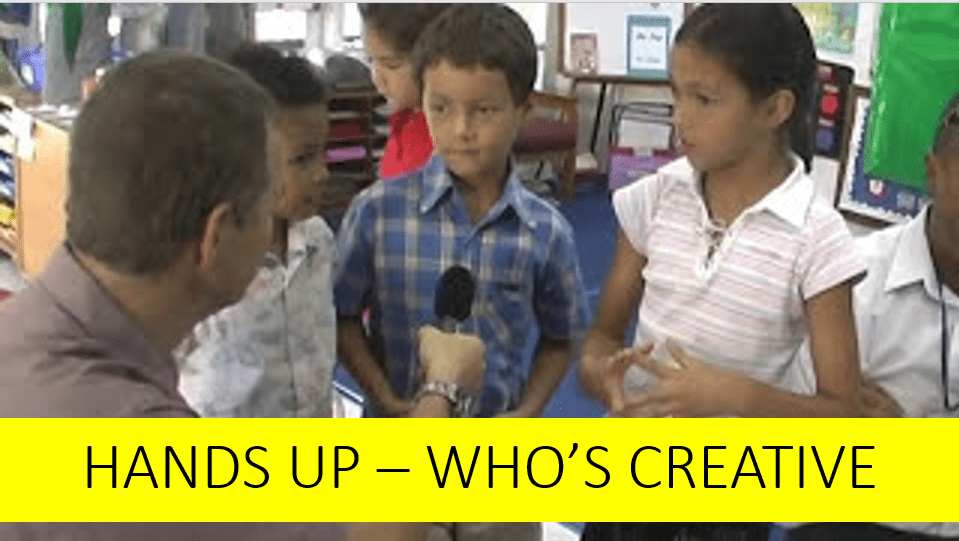Is there a crisis in creative confidence in the workplace?
By Andrew & Gaia Grant
We could be facing a crisis in creative confidence. With budgets slashed and resources cut, many people are being asked to do more with less – but few feel adequately equipped. The future will clearly require superior innovative thinking and problem solving skills, and yet so many feel paralyzed to act quickly and confidently when it comes to finding new ideas and solutions. Who is to blame for the apparent crisis in creative development? And how can leaders create and nurture an environment that supports creative thinking and development?
Tirian has surveyed thousands of international seminar participants from companies based in Asia to ask if they think they think they were more creative at age 7 than they are currently. Of the respondents, over 80% have indicated they believe their level of creativity has declined, and many reveal that they struggle with being creative in their current work environment.
This has led us to wonder what role – if any – the education process may play in the apparent demise of creative confidence. As parents, we have been interested to observe how our children’s attitudes have rapidly transformed from the excited enthusiasm of early learning experiences to the ambivalence and then resentment as school becomes a chore rather than an opportunity, more of an information factory than an exploratory play space. We can remember a clear example of how dramatic this change can be when our daughter was in grade 6. Only a few days into Term 1, she left the car with relative enthusiasm and passion for learning but by that afternoon she had returned a different person, deflated and disillusioned. When we gently approached the teacher to find out what had changed, we first noted the classroom environment was in stark contrast to the colorful interactive learning space she had enjoyed right through to grade 5. The teacher explained that the desks were now all in rows and there was no need for the additional stimulation in the environment as was she was ‘preparing the students for high school’. A significant milestone in our daughter’s education – and unfortunately not a positive one! Her love of learning has been rapidly diminishing ever since.
Certainly, as John Corrigan from Group 8 Education has pointed out, schools were originally designed in the 1800s primarily to discipline children as a form of social control. Up until recently schools have acted as information packaging factory lines – filling students with information then asking them to present this same information back out again through exams. Have schools focused too much on a rote learning approach, churning out individuals who are taught to repeat facts and figures rather than to think creatively and independently? As we attempt to emerge from this challenging past, we may continue to be limited by the accompanying shackles more than we realize.
IMAGINING A CREATIVE FUTURE
More developed cultures are now gradually becoming more successful in breaking free from the stifling philosophy that hampers creativity. By emphasizing the importance of the process as much as the result, and by encouraging alternative ideas and strategies, the education system is evolving towards creative thinking and problem solving methodologies – and those that emerge from the most advanced modern education systems are now finding they have had their creative thinking skills enhanced rather than diminished. A recent survey by The Creative Leadership Forum has in fact found that for the Australians they have surveyed, over 80% of them believe they are creative as adults and managers.
While past generations may have been able to fulfill their work duties effectively as the output requirements were more limited, it might only be people with innovative thinking skills that will survive the future. As tasks and even information become more automated, higher level thinking skills will become more and more necessary. Dan Pink explores this concept effectively when he talks about how today’s worker needs to be able to go:
- beyond function to include design
- beyond argument to include story
- beyond analysing to include synthesis (the ability to put together the pieces)
- beyond logic to include the need for empathy
- beyond seriousness to add in an element of play
- beyond accumulation to enrich this with meaning
What has your experience with the creative thinking journey been? Do you feel you have lost your ability to be creative – or has your creative ability in fact been enhanced over time, and what do you believe has led to this? How comfortable are you with the concept of creativity, and how important do you think it is as a skill?
CREATIVE INNOCENCE AND THE NEW LEADER
For years both the schooling system and society in general have rewarded knowledgeable experts. The people who have been able to successfully negotiate these systems were blessed with high test results and grades, and were then promoted to high positions and paid according to their knowledge and expertise. Now, with a greater amount of information more widely available, it is becoming obvious that it is not possible to for one person to be the single expert, so learning and leadership models will have to adapt. Leaders won’t now need to have the most information but be able to spot and encourage the smartest ideas. The traditional expert’s focus is very narrow, which means they can build a great deal of knowledge about one specific subject or area – but this can kill creativity, so the leader of the future may need to be a broad thinker capable of opening up thinking and ideas.
De Bono believes that creative thinking at work requires a certain level of creative innocence. So how is it possible to ensure creative innocence in the workplace when it often goes against the grain? It is only the innocent mind – the mind that is open, the mind that is willing to become vulnerable and take risks, that can feel and think as a child, that is unpressured and uncluttered – only this mind can be truly creative.
This concept of creative innocence is now recognized as so important that some organizations engage children in the ideas generation process. Toyota has been known to put together a “board” of children to advise them on product development. Hasbro has done the same with toys, and at Xerox’s Palo Alto Research Center they have asked school kids to attend a series of brainstorming sessions on the future of technology.
“The development of knowledge may depend on maintaining an influx of the naïve and the ignorant.”
Organizational development expert James G March
REVEALING THE CREATIVE CRISIS CULPRITS
There seem to be a number of factors in the education and then work environments that have contributed to this crisis in creative confidence. These could include:
- Insulation from diversity: We can become protected from the need to think creatively if we are not exposed to diverse ideas and people from diverse backgrounds. As we grow older we then end up continuing to protect ourselves from new ideas. To gain a feeling of security we often try to gather round us like minded people that insulate us from new experiences.
- Insecurity and stress: Secondly, the pressures of the modern environment can actually inhibit creative thinking. Creative thinking needs to be processed through the more advanced reflective frontal lobe of the brain, which research company Group 8 Education refers to as the ‘blue zone’, and when we are stressed or anxious, when we feel insecure or not listened to, our brain resources are drained away to dealing with the immediate needs of the more primitive survival functions of the base stem of the brain – what they call the ‘red zone’.
- Inability to play: Perhaps the crisis in creativity can also be associated with the expectation that we should become more serious and stop ‘playing’ as we get older. This idea was certainly implied through our survey. As we used a show of hands to indicate self assessments of creativity, there may have been a reluctance to admit to being creative over time. As many older children and adults seem to be reluctant to raise their hands in front of others when asked if they are creative, while children certainly eagerly raise their hands when asked the same questions, it has made us wonder if as we get older we do not want to be seen to be creative. Indeed, accompanying discussions of the definition of creativity can often indicate that creativity is associated with immature childish play rather than the mature seriousness of ‘real’ work. So creativity can become a quality you’d prefer to leave behind as you progress through life.
By dealing with these culprits and building environments that support the creative thinking process, it is possible to bring about dramatic change.
BUILDING CREATIVE CONFIDENCE: Hands Up
After reflecting on the results of our seminar survey, we decided to produce a video to get people thinking about creativity and their own creative thinking journey – a video we called ‘Hands Up’. We wanted to show what we had discovered first-hand through teaching thousands of school children, and then working with adults in adult learning environments. Our findings, as revealed in the video as a decline in creative engagement and confidence, correlate to Group 8 Education findings* from research with over 1000 students that engagement drops off from Kindergarten to Grade 10 due to an environment that often fails to provide the respect and security needed to nurture open thinking and learning.
In order to foster creative thinking, then, it becomes obvious that we will need to:
- Encourage diversity: While many people continue to build homogeneous like-minded teams, it will be important to find structures to support heterogeneous diverse teams, and to allow for a range of individuals and ideas.
- Minimise stress: Individuals report that in ideal school and workplace environments, says Group 8, three key qualities stand out:1. Teachers/leaders respect me2. Teacher/leaders are friendly, approachable and willing to listen3. Teachers/leaders encourage and help me to succeed.The Gallup organization has also identified that the best leaders create an environment in which people feel they can build trust and develop solid relationships. This environment provides individuals with the opportunity to take risks with learning and develop in a safe and accepting environment.
- Design open ‘playful’ environments: Free play creates a mental state where it is possible to feel safe and secure and to explore ideas without restrictions. The parents that try to maximize the education opportunities for their children by shuffling them between countless after school activities and rigorous study schedules may actually be in danger of shutting down the innovative creative part of the brain as the children struggle to get through their day in exhaustion. Research is now showing that adults who have less play time as children are less creative as adults. Melinda Wenner has revealed in the Scientific American that children (and animals) who do not ‘free play’ when they are young may grow into anxious, socially maladjusted adults. Free play is one of the conduits needed to ensure brain resources are diverted away from dealing with the primitive survival functions so they can access creative thinking. If creative thinking has not been accessed regularly, strong pathways in the brain cannot be established, and the ability to think creatively can actually wither away. As a university lecturer in Taiwan has found, “The major problem for education here is the lack of curiosity and initiative among the students. They are inordinately shy, don’t ask questions and reluctant to respond.”
Smart leaders recognize that the work environment could be inhibiting creativity, and learn to ensure they maintain a creative development focus. Management Guru Jim Collins consciously ensures that he spends only 50% of his time on administration tasks. He says that he turns down many keynote talks, consulting work and even the temptation to grow his company to ensure that he is disciplined enough to stay focused and creative. He is so adamant about this key point that he logs everything he does including his sleep. He knows that at the times that he is overworked with administration that his creative thinking and ability to focus on developing and researching new ideas suffers.
So do we lose our creativity as we become adults? It appears to be more the case that we lose our creative confidence, and as a result need to work harder to regain it. It appears that it’s not that adults are not creative, but rather the right environments and opportunities need to be built for creativity to flourish. And we must be committed to doing this in order to ensure we can all cope with the demands of the future.
- How aware we are of your cycles, the causes and effects of your attitudes and behaviours?
- How much time do you spend in a stressful adrenalin charge environment at work?
- How can you consciously set aside time and be disciplined to develop your creative thinking?
- Do you and your team feel: 1) Safe 2) Believed in, 3)Listened to 4) Respected?
- For leaders, what type of environment are you providing for your team? Whats sorts of opportunities for creative development are you providing for them?

Gaia Grant (PhD) is a lecturer and researcher at the University of Sydney Business School in the Discipline of Strategy, Innovation, and Entrepreneurship, focusing on research into innovation paradoxes and ambidextrous leadership. Gaia is also a Director of Tirian Innovative Solutions, & the co-author (with Andrew Grant) of a number of books including ‘The Innovation Race’, and “Who Killed Creativity?”.

Andrew Grant is the Director of Tirian Innovative Solutions, and co-author (with Dr Gaia Grant) of a number of books including ‘The Innovation Race’, and “Who Killed Creativity?”.


